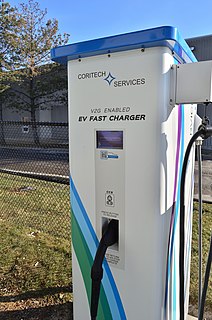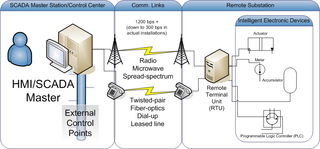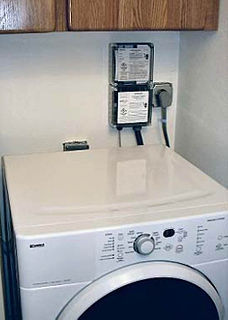Related Research Articles
Power-line communication carries data on a conductor that is also used simultaneously for AC electric power transmission or electric power distribution to consumers.
Distributed generation, also distributed energy, on-site generation (OSG), or district/decentralized energy, is electrical generation and storage performed by a variety of small, grid-connected or distribution system-connected devices referred to as distributed energy resources (DER).
HomePlug is the family name for various power line communications specifications under the HomePlug designation, with each offering unique performance capabilities and coexistence or compatibility with other HomePlug specifications.

A variable-frequency drive (VFD) is a type of motor drive used in electro-mechanical drive systems to control AC motor speed and torque by varying motor input frequency and, depending on topology, to control associated voltage or current variation. VFDs may also be known as 'AFDs', 'ASDs', 'VSDs', 'AC drives', 'micro drives', 'inverter drives' or, simply, 'drives'.

Vehicle-to-grid (V2G) describes a system in which plug-in electric vehicles (PEV), such as battery electric vehicles (BEV), plug-in hybrids (PHEV) or hydrogen fuel cell electric vehicles (FCEV), communicate with the power grid to sell demand response services by either returning electricity to the grid or by throttling their charging rate. V2G storage capabilities can enable EVs to store and discharge electricity generated from renewable energy sources such as solar and wind, with output that fluctuates depending on weather and time of day.

Distributed Network Protocol 3 (DNP3) is a set of communications protocols used between components in process automation systems. Its main use is in utilities such as electric and water companies. Usage in other industries is not common. It was developed for communications between various types of data acquisition and control equipment. It plays a crucial role in SCADA systems, where it is used by SCADA Master Stations, Remote Terminal Units (RTUs), and Intelligent Electronic Devices (IEDs). It is primarily used for communications between a master station and RTUs or IEDs. ICCP, the Inter-Control Center Communications Protocol, is used for inter-master station communications. Competing standards include the older Modbus protocol and the newer IEC 61850 protocol.

Demand response is a change in the power consumption of an electric utility customer to better match the demand for power with the supply. Until recently electric energy could not be easily stored, so utilities have traditionally matched demand and supply by throttling the production rate of their power plants, taking generating units on or off line, or importing power from other utilities. There are limits to what can be achieved on the supply side, because some generating units can take a long time to come up to full power, some units may be very expensive to operate, and demand can at times be greater than the capacity of all the available power plants put together. Demand response seeks to adjust the demand for power instead of adjusting the supply.
A microgrid is a decentralized group of electricity sources and loads that normally operates, connected to and synchronous with the traditional wide area synchronous grid (macrogrid), but is able to disconnect from the interconnected grid and to function autonomously in "island mode" as technical or economic conditions dictate. In this way, microgrids improve the security of supply within the microgrid cell, and can supply emergency power, changing between island and connected modes.
The IEEE Std 1901-2010 is a standard for high speed communication devices via electric power lines, often called broadband over power lines (BPL). The standard uses transmission frequencies below 100 MHz. This standard is usable by all classes of BPL devices, including BPL devices used for the connection to Internet access services as well as BPL devices used within buildings for local area networks, smart energy applications, transportation platforms (vehicle), and other data distribution applications.

A smart meter is an electronic device that records information such as consumption of electric energy, voltage levels, current, and power factor. Smart meters communicate the information to the consumer for greater clarity of consumption behavior, and electricity suppliers for system monitoring and customer billing. Smart meters typically record energy near real-time, and report regularly, short intervals throughout the day. Smart meters enable two-way communication between the meter and the central system. Such an advanced metering infrastructure (AMI) differs from automatic meter reading (AMR) in that it enables two-way communication between the meter and the supplier. Communications from the meter to the network may be wireless, or via fixed wired connections such as power line carrier (PLC). Wireless communication options in common use include cellular communications, Wi-Fi, wireless ad hoc networks over Wi-Fi, wireless mesh networks, low power long-range wireless (LoRa), Wize ZigBee, and Wi-SUN.

A phasor measurement unit (PMU) is a device used to estimate the magnitude and phase angle of an electrical phasor quantity in the electricity grid using a common time source for synchronization. Time synchronization is usually provided by GPS or IEEE 1588 Precision Time Protocol, which allows synchronized real-time measurements of multiple remote points on the grid. PMUs are capable of capturing samples from a waveform in quick succession and reconstructing the phasor quantity, made up of an angle measurement and a magnitude measurement. The resulting measurement is known as a synchrophasor. These time synchronized measurements are important because if the grid’s supply and demand are not perfectly matched, frequency imbalances can cause stress on the grid, which is a potential cause for power outages.

A smart grid is an electrical grid which includes a variety of operation and energy measures including:

An electrical grid is an interconnected network for electricity delivery from producers to consumers. Electrical grids vary in size and can cover whole countries or continents. It consists of:
The term Smart Grid is most commonly defined as an electric grid that has been digitized to enable two way communication between producers and consumers. The objective of the Smart Grid is to update electricity infrastructure to include more advanced communication, control, and sensory technology with the hope of increasing communication between consumers and energy producers. The potential benefits from a Smart Grid include increased reliability, more efficient electricity use, better economics, and improved sustainability.
The term Smart Grid describes a next-generation electric power system that is classified by the increased use of communication and information technology in the generation, delivery, and consumption of electrical energy. For individual consumers, smart grid technology offers more control over electricity consumption. Typically, the goal is greater overall energy efficiency.

IEEE Smart Grid is an initiative launched by IEEE to help provide expertise and guidance for individuals and organizations involved in the modernization and optimization of the power grid, better known as the "smart grid". IEEE Smart Grid encompasses an array of activities, including development of new smart grid-related standards, best practices, publications, and conferences and educational opportunities.
The Open Smart Grid Protocol (OSGP) is a family of specifications published by the European Telecommunications Standards Institute (ETSI) used in conjunction with the ISO/IEC 14908 control networking standard for smart grid applications. OSGP is optimized to provide reliable and efficient delivery of command and control information for smart meters, direct load control modules, solar panels, gateways, and other smart grid devices. With over 5 million OSGP based smart meters and devices deployed worldwide it is one of the most widely used smart meter and smart grid device networking standards.
The UCLA Smart Grid Energy Research Center (SMERC), located on the University of California Los Angeles (UCLA) campus, is an organization focused on developing the next generation of technologies and innovation for the SmartGrid. Partnerships with government, technology providers, DOE research labs and universities, utilities, policy makers, and electric vehicle and appliance manufacturers provide SMERC with diverse capabilities and exceptional, matured leadership.
Smart Grid Interoperability Panel or SGIP is an organization that defines requirements for a smarter electric grid by driving interoperability, the use of standard, and collaborating across organizations to address gaps and issue hindering the deployment of smart grid technologies.
Transactive energy refers to the economic and control techniques used to manage the flow or exchange of energy within an existing electric power system in regards to economic and market based standard values of energy. It is a concept that is used in an effort to improve the efficiency and reliability of the power system, pointing towards a more intelligent and interactive future for the energy industry.
References
- ↑ "IEEE P2030 Official Website" . Retrieved 6 March 2012.
- ↑ "IEEE, conference drive smart grids – P2030 aims to develop a guide to grid standards". EETimes.com. Archived from the original on 22 January 2013. Retrieved 6 March 2012.
- ↑ "Black Hat USA 2009" . Retrieved 6 March 2012.
- ↑ "Buggy 'smart meters' open door to power-grid botnet". 12 June 2009. Retrieved 6 March 2012.
- 1 2 "IEEE Unifies Power, Communications and IT with Launch of Smart Grid Interoperability Standards Project P2030". 4 May 2009. Retrieved 6 March 2012.
- ↑ "IEEE P2030 Draft Guide for Smart Grid Interoperability" . Retrieved 6 March 2012.
- ↑ "IEEE Standards Coordinating Committee 21 (SCC21) Official Website".
- ↑ "IEEE Smart Grid Portal". Archived from the original on 23 April 2012. Retrieved 28 January 2013.
- ↑ IEEE Guide for Smart Grid Interoperability of Energy Technology and Information Technology Operation with the Electric Power System (EPS), End-Use Applications, and Loads. IEEE Std 2030-2011. IEEE. 10 September 2011. ISBN 9780738167282.